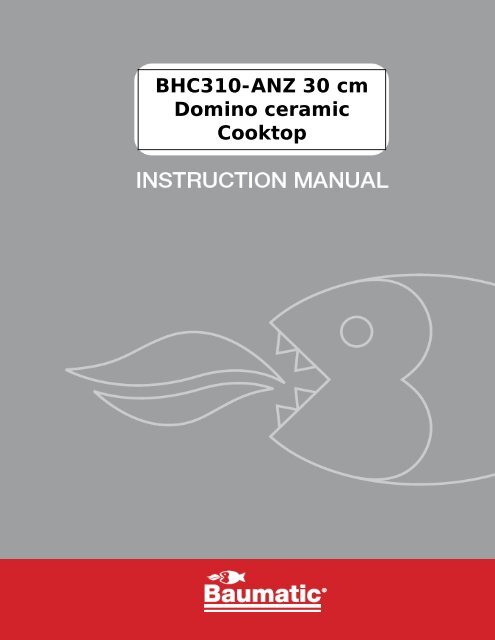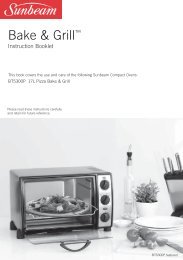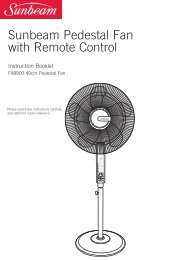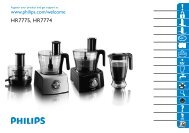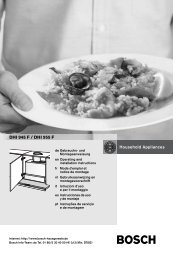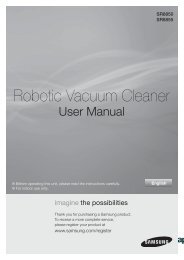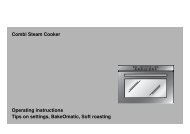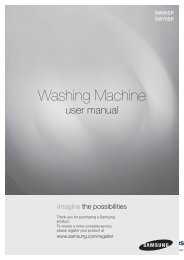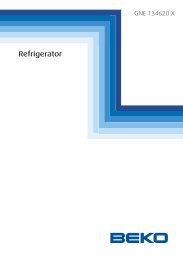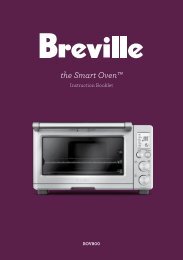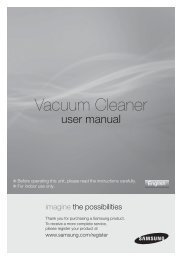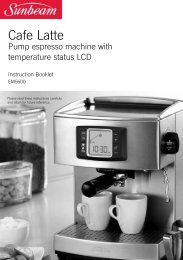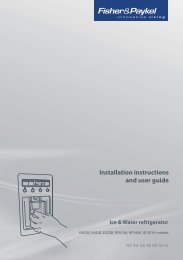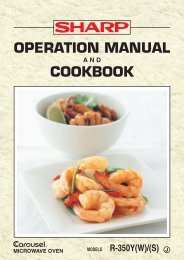BHC310-ANZ 30 cm Domino ceramic Cooktop - Appliances Online
BHC310-ANZ 30 cm Domino ceramic Cooktop - Appliances Online
BHC310-ANZ 30 cm Domino ceramic Cooktop - Appliances Online
Create successful ePaper yourself
Turn your PDF publications into a flip-book with our unique Google optimized e-Paper software.
<strong>BHC310</strong>-<strong>ANZ</strong> <strong>30</strong> <strong>cm</strong><br />
<strong>Domino</strong> <strong>ceramic</strong><br />
<strong>Cooktop</strong>
User Manual for your Baumatic<br />
<strong>BHC310</strong>-<strong>ANZ</strong><br />
<strong>30</strong> <strong>cm</strong> <strong>Domino</strong> <strong>ceramic</strong> cooktop with<br />
touch control operation<br />
NOTE: This User Instruction Manual contains important<br />
information, including safety & installation points, which will<br />
enable you to get the most out of your appliance. Please keep it<br />
in a safe place so that it is easily available for future reference; for<br />
you or any person not familiar with the operation of the appliance.<br />
JW 13/07/12<br />
2
Contents<br />
Environmental note 4<br />
Important safety information 5 – 7<br />
Specifications 8 - 10<br />
Product and aperture dimensions 8<br />
Product specifications 8<br />
Standard accessories 8<br />
Electrical details 8<br />
Ceramic hob surface layout 9<br />
Control panel 10<br />
Using the <strong>ceramic</strong> hob 10 - 18<br />
Before first use 10<br />
Using the touch controls 10<br />
Cooking on a zone 11<br />
Power level settings 12<br />
Turning off the zone 12<br />
Residual heat indicator 13<br />
Locking the hob top 13<br />
Using the timer as a minute minder 14<br />
Setting the timer to turn one cooking zone off 15<br />
High temperature protection 16<br />
Automatic safety cut-off 16<br />
Suitable cookware 16<br />
Cooking tips 17<br />
Hob guidelines 18<br />
Cleaning and maintenance 20 - 21<br />
Cleaning the <strong>ceramic</strong> hob top 20<br />
After each use 20<br />
Cleaning table 20<br />
Using a <strong>ceramic</strong> hob scraper 21<br />
Using a specialist <strong>ceramic</strong> hob cleaner 21<br />
Installation 22 - 26<br />
Positioning 22<br />
Unpacking the appliance 22<br />
Installing the appliance 23 - 25<br />
Electrical connection 25 - 26<br />
My appliance isn’t working correctly 27 – 28<br />
Contact details 29<br />
3
Environmental note<br />
o The packaging materials that Baumatic uses are environmentally<br />
friendly and can be recycled.<br />
o Please discard<br />
environment.<br />
all packaging material with due regard for the<br />
4
Important safety information<br />
General Information<br />
o<br />
Your safety is of the utmost importance to Baumatic.<br />
Please make sure that you read this instruction booklet<br />
before attempting to install or use the appliance. If you<br />
are unsure of any of the information contained in this<br />
booklet, please contact the Retailer where you<br />
purchased<br />
your unit from.<br />
This appliance is designed for domestic household<br />
use and for<br />
the cooking and frying of domestic foodstuffs.<br />
o IMPORTANT: The adjacent furniture or housing and all<br />
materials used in the installation must be able to withstand a<br />
minimum temperature of 85°C above the ambient temperature<br />
of the room it is located in, whilst in use.<br />
o Certain types of vinyl or laminate kitchen furniture are<br />
particularly prone to heat damage or discolouration<br />
at<br />
temperatures below the guidelines given above.<br />
o Any damage caused by the appliance being installed in<br />
contravention of this temperature limit, will be the liability of<br />
the owner.<br />
o Your new appliance is guaranteed against electrical or<br />
mechanical defects, subject to certain exclusions that are noted<br />
in the Conditions Of Guarantee.<br />
The foregoing does not affect<br />
your statutory rights.<br />
o The use of this appliance for any other purpose or in any other<br />
environment without the express agreement<br />
of Baumatic Ltd.<br />
will invalidate any warranty or liability claim.<br />
o You should<br />
not use this appliance to store items on or as a work<br />
surface.<br />
o No modifications to the appliance are permitted by Baumatic Ltd.<br />
o You should not store or place flammable or highly flammable<br />
liquids/materials on top of or near the appliance. Items made<br />
from aluminium, plastic or plastic film should also be kept away<br />
from the appliance, as they may fuse to the surface.<br />
o Repairs<br />
agents.<br />
may only be carried out by authorised service<br />
5
Child<br />
Safety<br />
o Baumatic strongly recommend that babies and young children<br />
are prevented from being near to the appliance and not allowed<br />
to touch the appliance<br />
at any time. During and after use, all<br />
surfaces will be hot.<br />
o If it is necessary for younger family members to be in the<br />
kitchen, please<br />
ensure that they are kept under close supervision<br />
at all times.<br />
o Older children should<br />
only be allowed to utilise the appliance<br />
when supervised.<br />
General<br />
Safety<br />
The appliance should only be installed and connected by a<br />
suitably qualified person.<br />
Care should be taken to ensure that the units and work surfaces<br />
that you build the appliance into, meet with the relevant<br />
standards.<br />
If you notice any scratches, splits or cracks in the <strong>ceramic</strong> glass,<br />
you should immediately switch off the appliance and disconnect<br />
it from your mains supply. Otherwise there is the risk of electric<br />
shock occurring.<br />
During<br />
use<br />
Any film or stickers that are present on the hob surface when it<br />
is delivered should be removed before use.<br />
Care should be used when utilising the appliance, otherwise<br />
there is a risk of burns being caused.<br />
o You should not allow the electrical connection cables to come<br />
into contact<br />
with the hob surface when it is hot or any hot<br />
cookware.<br />
o If fat and oil overheats, then it can ignite extremely quickly. For<br />
this reason, when cooking<br />
with fat and oil the appliance should<br />
not be left unattended.<br />
Make sure that all of the cooking zones are switched off after<br />
use.<br />
6
Cleaning<br />
o<br />
Cleaning of the hob should be carried out on a regular basis.<br />
o IMPORTANT: Before attempting to clean the<br />
should be disconnected from the mains and cool.<br />
o Great care should be taken whilst<br />
following the cleaning procedure.<br />
o You should not use a steam jet or any<br />
cleaning equipment to clean the appliance.<br />
Installation<br />
appliance, it<br />
using this appliance and when<br />
other high pressure<br />
This appliance must be correctly installed by a<br />
suitably qualified person, strictly in accordance<br />
with the manufacturer’s instructions. Please see<br />
the specific section of this booklet that refers to<br />
installation.<br />
o Baumatic Ltd. declines any responsibility for injury or<br />
damage, to person or property, as a result of improper<br />
use or installation of this appliance.<br />
To<br />
avoid damaging your appliance<br />
o<br />
The <strong>ceramic</strong> glass can be damaged by objects falling onto it.<br />
o The <strong>ceramic</strong><br />
glass edge can be damaged by knocks from<br />
cookware.<br />
o Cast iron and cast aluminium cookware with damaged bases<br />
may scratch the <strong>ceramic</strong> surface if they are dragged across it.<br />
o Pans should<br />
be lifted on and off the hob surface and not<br />
dragged.<br />
o Cooking zones should not be switched on without<br />
placed on it. Also the cookware should not be empty.<br />
cookware<br />
o Food or liquid that has high sugar content may damage the hob<br />
top if it comes into contact with the <strong>ceramic</strong> hob surface. Any<br />
spillages should be wiped up immediately, however<br />
this may not<br />
prevent the hob surface from becoming damaged.<br />
7
Specifications<br />
Product dimensions: Aperture dimensions:<br />
Depth: 520 mm Depth: 505 mm<br />
Width: 288 mm Width: 273 mm<br />
Height: 55 mm<br />
Product specifications<br />
o 1 x 1.80 kW hyper-speed zon e<br />
o 1 x 1.20 kW hyper-speed zone<br />
o Front touch control operation<br />
o Residual heat<br />
indicator<br />
o Safety lock<br />
Standard accessories<br />
o Ceramic hob scraper<br />
Electrical details<br />
Rated Voltage: 220 - 240 Vac 50 - 60 Hz<br />
Supply Connection: 15 A<br />
Max Rated Inputs: 3.00 kW<br />
Mains<br />
Supply Lead: 3 core x 1.5 mm² (supplied)<br />
8
For future reference please record the following information which can<br />
be found on the rating plate and the date of purchase which can be<br />
found on your sales invoice. The rating plate of your<br />
hob is located on<br />
the<br />
underneath of the appliance. Therefore it is a good idea to record<br />
this<br />
information before you install your appliance.<br />
Model Number ……………………………….<br />
Serial Number ……………………………….<br />
Date<br />
of Purchase ……………………………….<br />
Ceramic hob surface layout<br />
1 = 1.80 kW hyper-speed<br />
zone<br />
2 = 1.20 kW hyper-speed<br />
zone<br />
3 = Glass hob surface<br />
4 = ON / OFF button<br />
5 = Control<br />
panel<br />
9
Control panel<br />
1 = ON / OFF button<br />
2 = Power / time regulation<br />
buttons<br />
3 = Cooking zone selection buttons<br />
4 = Timer button<br />
5 = Safety lock button<br />
Using the <strong>ceramic</strong> hob<br />
Before first use<br />
IMPORTANT: You should clean the <strong>ceramic</strong> hob surface (see<br />
“Cleaning and maintenance” section).<br />
o You should switch on one cooking zone<br />
at a time, for 5 minutes<br />
at the maximum setting. This will help to eliminate any new<br />
smell that exists and evaporate any humidity that has formed on<br />
the heating elements during transit.<br />
o Do not burn off more than one zone at once.<br />
o You must place a saucepan<br />
filled half full with cold water on<br />
each zone as you burn it off.<br />
Using the touch controls<br />
o All operations are performed by means of the touch controls that<br />
can be found<br />
at the front of the hob top.<br />
o The controls respond to touch so you do not need to apply any<br />
pressure.<br />
o You should use the ball of your finger to press a button and not<br />
its tip.<br />
10
o A beep will sound each time a touch is registered.<br />
o You should make sure that the touch controls are always clean<br />
and dry and that there<br />
is no object, such as utensils or cloths,<br />
covering them. Even a thin film of water may make the controls<br />
difficult to operate.<br />
Cooking on a zone<br />
o After powering on the appliance a buzzer will sound once and all<br />
the indicator<br />
lights will come on for 1 second and then go out.<br />
This indicates<br />
that the hob has entered stand-by mode.<br />
o<br />
o<br />
Press the ON/OFF button (1) and all the indicators<br />
will show “-“.<br />
o Place a suitable pan on the cooking zone that<br />
you wish to use. Ensure<br />
that the bottom of<br />
the pan and the surface of the cooking zone<br />
are clean and dry.<br />
Touch the relevant cooking zone selection button<br />
(3).<br />
o<br />
o Choose an appropriate power setting for the<br />
food that you are cooking using the power<br />
regulation buttons (2). If you don’t choose a<br />
power level within<br />
1 minute, the hob will<br />
automatically switch off and you will need to<br />
start again.<br />
You are able to adjust the power level at any<br />
time<br />
during cooking.<br />
11
Power level settings<br />
o The settings below are to be used as a guideline only. The<br />
exact<br />
setting required will depend on several factors, including your<br />
cookware and the amount of food that you are cooking.<br />
o You should experiment with the induction hob power levels to<br />
find the best settings to suit you.<br />
Power<br />
Suggested use<br />
setting<br />
1 – 2 o Delicate warming for small amounts of food.<br />
o Melting chocolate, butter and foods that burn<br />
quickly.<br />
o Gentle simmering.<br />
o Slow warming.<br />
3 – 4 o Reheating.<br />
o Rapid simmering.<br />
o Cooking rice.<br />
5 – 6 o Pancakes.<br />
7 – 8 o Sautéing.<br />
o Cooking pasta.<br />
9<br />
o Stir-frying.<br />
o Searing.<br />
o Bringing soup to the boil.<br />
o Boiling<br />
water.<br />
Turning off the zone<br />
o When you have finished cooking, press the<br />
cooking zone selection button (3) of the zone<br />
that you wish to turn off.<br />
o Use the power regulation buttons (2) to set the<br />
power level to 0 or press the plus and<br />
minus<br />
buttons together to set the power level to 0.<br />
o You can then turn the whole hob off by pressing the<br />
ON/OFF button (1).<br />
12
Residual heat indicator<br />
o After a zone is switched off, the display will<br />
show the letter “H”. This<br />
means that the<br />
temperature of the indicated zone is still high<br />
enough to cause injury.<br />
o When the temperature falls to a safe temperature, then the<br />
letter “H” will go out.<br />
o<br />
o<br />
The residual heat can also be used to continue heating pans on<br />
the cooking zone that is still hot to save energy.<br />
IMPORTANT: The residual heat indicator will disappear if your<br />
mains supply is cut.<br />
Locking the hob top<br />
o You can lock the controls on the front of the hob to prevent<br />
unintended operation by other persons such as children.<br />
o When the controls are locked, all the buttons are disabled except<br />
for the ON/OFF button.<br />
o To lock the controls, press the safety lock button (5). The timer<br />
display will show “Lo”.<br />
o To unlock the controls, make sure that the hob is turned on and<br />
then press the safety<br />
lock button (5) again for a few seconds.<br />
“Lo” will disappear from the timer display and the safety lock will<br />
be deactivated.<br />
13
Using the timer as a minute minder<br />
It is possible<br />
to use the minute minder, even if you are not turning on<br />
a cooking zone.<br />
o Touch the timer button (4) and the timer<br />
display will show “- -“.<br />
o Use the time regulation buttons (2) to set the<br />
required countdown time. The minute minder<br />
indicator will start flashing<br />
and will show in<br />
the timer display. The maximum time that can<br />
be set is 99 minutes.<br />
o Each press of the plus or minus button will increase or decrease<br />
the time by 1 minute. If you press and hold the plus or minus<br />
button, the time will increase or decrease by 10 minutes.<br />
o If the set time exceeds 99 minutes, the timer automatically<br />
returns to 0 minutes.<br />
o If you press the plus and minus buttons together, the set time<br />
will be cancelled and “- -“ will show in the timer display.<br />
o When the required time is displayed, the<br />
countdown will begin immediately. The<br />
display will show the remaining time and<br />
the timer indicator will flash for 5 seconds.<br />
o When the programmed<br />
time is reached, a buzzer<br />
will sound for <strong>30</strong> seconds and the timer display<br />
will show “- -“.<br />
14
Setting the timer to turn one cooking zone off<br />
You are able to link the timer to a cooking zone so after the countdown<br />
time is complete, the cooking zone will turn off automatically.<br />
o Press the relevant cooking<br />
zone selection button<br />
(3) for the zone that you wish to link a<br />
countdown time to.<br />
o Touch the timer button (4) and the timer<br />
display will show “10”.<br />
o Use the desired countdown time using the<br />
time regulation buttons (2). Each press of<br />
the plus or minus button will increase or<br />
decrease the time by 1 minute. By holding<br />
down the plus or minus button, the time will<br />
increase or decrease by 10 minutes.<br />
If the<br />
set time exceeds 99 minutes, the timer will<br />
automatically return to 0 minutes.<br />
o If you press the plus and minus buttons together, the timer will<br />
be cancelled and the timer display will show “- -“.<br />
o When the required time has been set, the<br />
countdown will begin immediately. The<br />
display will show the remaining time and<br />
the timer indicator will flash for 5 seconds.<br />
o A red dot will appear next to the power level<br />
indicator to show which zone has the timer linked<br />
to it.<br />
15
o When the countdown is complete, the corresponding zone will<br />
turn off automatically.<br />
IMPORTANT:<br />
When the countdown is complete, if the other<br />
cooking zone is in use, it will continue to heat. You will need to<br />
turn<br />
the other cooking zone off manually.<br />
High temperature protection<br />
o A temperature sensor in the hob can monitor the temperature<br />
inside of the hob. When<br />
an excessively high temperature is<br />
detected, the hob will turn off automatically.<br />
Automatic safety cut-off<br />
o The automatic safety cut-off is activated when a cooking zone<br />
has been left on longer than the maximum default working time.<br />
This is a safety function in the event of the hob being left on<br />
accidentally.<br />
o The default working times for the various power levels are shown<br />
in the table below.<br />
Power level 1 2 3 4 5 6 7 8 9<br />
Default working time (hours) 8 8 8 4 4 4 2 2 2<br />
Suitable cookware<br />
o Do not use cookware with jagged edges or a curved<br />
base.<br />
o Make sure that the base of your pan is smooth and sits flat<br />
against the glass. It should also be the same size as the cooking<br />
zone. Always ensure that your pan is centred on the zone.<br />
16
o Always lift pans off the <strong>ceramic</strong> hob, do not slide them as they<br />
could scratch the glass.<br />
Cooking tips<br />
o IMPORTANT: Take care when frying as the oil and fat heat<br />
up very quickly. At extremely high temperatures oil and<br />
fat will ignite spontaneously and this presents a serious<br />
fire risk.<br />
o When food comes to the boil, reduce the temperature setting.<br />
o Using a lid on pans will<br />
energy by retaining heat.<br />
o Minimise the amount of liquid or fat used in<br />
to reduce cooking times.<br />
reduce the cooking times and save<br />
the cooking process<br />
o Start cooking on a high power level setting and reduce the<br />
setting when the food has heated through.<br />
Simmering, cooking rice<br />
o Simmering occurs below boiling point, at around 85°C, when<br />
bubbles are just rising occasionally to the surface of the cooking<br />
liquid.<br />
o Simmering is the key to delicious soups and tender stews<br />
because the flavours develop without overcooking the food. You<br />
should also cook egg-based and flour-thickened sauces below<br />
boiling point.<br />
o Some tasks,<br />
including cooking rice by the absorption method,<br />
may require a slightly higher power setting to ensure the food is<br />
cooked properly in the recommended time.<br />
S earing steak<br />
tes before cooking.<br />
o To cook juicy and flavoursome steaks you should stand the meat<br />
at room temperature for about 20 minu<br />
17
o Heat up a heavy-based frying pan. Brush both sides of the steak<br />
with oil and drizzle a small amount of oil into the hot pan and<br />
then lower the meat into the hot pan.<br />
o Turn the steak only once during cooking. The exact cooking time<br />
will depend on the thickness of the steak and how well cooked<br />
you want it. Times may vary from about 2 – 8 minutes per side.<br />
Press the steak to gauge how cooked it is. The firmer it feels, the<br />
more “well done” it will be.<br />
o Leave the steak to rest on a warm plate for a few minutes to<br />
allow it to relax and become tender before serving.<br />
S tir-frying<br />
o Choose a suitable flat-based wok or a large frying pan.<br />
o Stir-frying should be quick so have all the ingredients<br />
and<br />
equipment ready.<br />
o If you are cooking large quantities, cook the food in several<br />
smaller batches.<br />
o Preheat the pan briefly and add two tablespoons of oil.<br />
o Cook any meat first and then put it aside and keep warm.<br />
o Stir-fry the vegetables and when they are hot but still crisp, turn<br />
the cooking zone to a lower setting. Return the meat to the pan<br />
and add your sauce.<br />
o<br />
Stir the ingredients gently to make sure they are heated<br />
through.<br />
o Serve immediately.<br />
Hob guidelines<br />
o The first few times the hob top is used, it may give off an acrid,<br />
burning smell. This smell will disappear completely with repeated<br />
use.<br />
o The worktop is fitted with cooking areas of different diameter<br />
and power.<br />
o The positions where the heat will radiate from are clearly marked<br />
on the hob top. The saucepans must be positioned exactly on<br />
these zones for efficient heating to occur. Pans should have the<br />
same diameter<br />
as the cooking zone that they are being used on.<br />
18
o You should not use saucepans with rough bottoms, as this can<br />
scratch the <strong>ceramic</strong> surface.<br />
o Before use, make sure that the bottoms of the saucepans are<br />
clean and dry.<br />
o When cold, the bottom of the pans should be slightly concave, as<br />
they expand when hot and lie flat on the surface of the hob. This<br />
will allow the heat to transfer more easily.<br />
o The best thickness for the bottom of the pans<br />
is 2 – 3 mm of<br />
enamelled steel and 4 – 6 mm for stainless steel with sandwich<br />
type bottoms.<br />
o If these rules are not followed, then there will be a great loss of<br />
heat and energy. Heat not absorbed by the saucepan, will spread<br />
to the hob, frame and surrounding<br />
cabinets.<br />
o Preferably cover pans with a lid to permit cooking at a lower<br />
heat.<br />
o Always cook vegetables and potatoes, etc. in as<br />
reduce cooking times.<br />
little water to<br />
o Food or liquid that has high sugar content may damage the hob<br />
top if it comes into contact with the <strong>ceramic</strong> hob surface.<br />
Any<br />
spillages should be wiped up immediately, however this may not<br />
prevent the hob surface from becoming damaged.<br />
o IMPORTANT: The <strong>ceramic</strong> hob<br />
surface is tough; however it is<br />
not unbreakable and can be damaged. Especially if pointed or<br />
hard objects are allowed to fall on it with some force.<br />
o DO NOT USE THE HOB IF THE SURFACE BECOMES BROKEN<br />
OR CRACKED. YOU SHOULD CONTACT THE SERVICE<br />
DEPARTMENT IMMEDIATELY.<br />
19
Cleaning and maintenance<br />
Cleaning operations must only be carried out<br />
when the hob is cool.<br />
The appliance should be disconnected from your<br />
mains supply before commencing any cleaning<br />
process.<br />
Cleaning<br />
the <strong>ceramic</strong> hob top<br />
Any residues that are left on the hob top surface from cleaning<br />
agents will damage it. You should remove any residues with<br />
warm water mixed with a little washing up liquid.<br />
Abrasive cleaners<br />
or sharp objects will damage the hob surface;<br />
you should clean it using warm water mixed with a little washing<br />
up liquid.<br />
You may find it easier to clean some deposits whilst the hob<br />
surface is still warm. However you should take care not to burn<br />
yourself if cleaning<br />
the hob surface when it is still warm.<br />
After each use<br />
o Wipe the appli ance over with a damp<br />
cloth.<br />
o Dry the appliance by rubbing the surface with a clean cloth.<br />
Clea ning table<br />
Type of deposit<br />
Sugar or<br />
food/liquid<br />
containing sugar<br />
Remove<br />
immediately?<br />
Remove<br />
when the<br />
appliance<br />
has cooled<br />
down?<br />
What should I<br />
u se to remove<br />
the deposit?<br />
Yes No Ceramic hob<br />
scraper<br />
Tin foil or plastic Yes No Ceramic hob<br />
scraper<br />
Fat splashes No Yes Ceramic hob<br />
cleaner<br />
Metallic<br />
No Yes Ceramic hob<br />
discolouration<br />
Water splashes or<br />
water rings<br />
cleaner<br />
No Yes Ceramic hob<br />
cleaner<br />
20
Using<br />
a <strong>ceramic</strong> hob scraper<br />
Your appliance will be provided with a hob scraper. The following<br />
guidelines should also be followed when using the <strong>ceramic</strong> hob<br />
scraper:-<br />
o The scraper should be placed on the <strong>ceramic</strong> surface at an angle.<br />
o Residues should be removed by sliding the blade carefully<br />
the <strong>ceramic</strong> surface.<br />
over<br />
o The <strong>ceramic</strong> surface should be wiped with a damp cloth that has<br />
been placed in warm water mixed with a small amount of<br />
washing up liquid.<br />
o Dry the appliance by rubbing the surface with a clean cloth.<br />
Using<br />
a specialist <strong>ceramic</strong> hob cleaner<br />
It is possible to purchase a specialist <strong>ceramic</strong> hob cleaner/conditioner.<br />
You<br />
should follow the instructions given by the manufacturer of the<br />
specialist<br />
<strong>ceramic</strong> hob cleaner. You should ensure that it is suitable for<br />
use<br />
on your appliance.<br />
21
Installation<br />
The installation must be carried out by a suitably<br />
qualified person, in accordance with the current<br />
version of the following.<br />
o AS/<br />
NZS <strong>30</strong>00: 2007 Wiring Regulations<br />
o 2010<br />
Electricity Safety Regulations<br />
Positioning<br />
The adjacent furniture must be able to withstand a<br />
minimum<br />
temperature rise of 85°C above the ambient<br />
temperature of the room it is located in, during<br />
periods of use.<br />
This appliance is classified as Class 3 and therefore is to be built into a<br />
kitchen unit (depending on size) or 600 mm worktop that is at least <strong>30</strong><br />
mm<br />
thick. The following minimum clearance<br />
distances must be<br />
observed:-<br />
o 760 mm between the hob surface and the underside of any<br />
horizontal surface above it.<br />
o 50 mm clearance around<br />
the front, back and sides of the<br />
appliance, measured from<br />
the cut out.<br />
o If the hob is positioned so that the right or left hand side of the<br />
appliance will be near to the edge<br />
of a kitchen unit. There must<br />
be a gap of at least<br />
150 mm between the side of the hob and the<br />
vertical surface of the kitchen unit.<br />
Unpacking the appliance<br />
When unpacking the<br />
appliance please check that the following items<br />
are contained within<br />
the packaging:-<br />
1 Baumatic hob<br />
1 Ceramic hob scraper<br />
1 Installation and instruction<br />
manual<br />
1 guarantee card<br />
4 Fixing brackets<br />
4 Fixing screws<br />
1 Sealing strip<br />
22
Installing the appliance<br />
o Cut a hole in the worktop that corresponds with the drawing<br />
shown above.<br />
o IMPORTANT: You must<br />
observe the ventilation<br />
requirements shown in<br />
the drawing opposite.<br />
23
o IMPORTANT: There are ventilation<br />
holes around the outside of the hob.<br />
YOU MUST ensure<br />
that these holes are<br />
not blocked by the work top, when you<br />
put the hob into position (see drawing<br />
opposite).<br />
o Carefully turn the hob upside down and<br />
place it on a cushioned mat.<br />
o Apply the sealing strip provided around<br />
the<br />
edge of the appliance.<br />
o<br />
The protective covering must be removed<br />
from both sides.<br />
o Do not leave a gap in the sealing agent or<br />
overlap the thickness.<br />
o IMPORTANT: Do not use a silicon sealant<br />
to seal the appliance against the aperture.<br />
This will make it difficult to remove the<br />
hob from<br />
the aperture in future,<br />
particularly if it needs to be serviced.<br />
o The supplied brackets need to be fitted<br />
to the fixing points on<br />
the underside<br />
of the hob.<br />
o Place a b racket onto each fixing, ensuring that the outer hole<br />
lines up with the hole on the hob.<br />
o Fasten the bracket to the position<br />
on the hob with a screw.<br />
Adjust the bracket position to suit different table top thicknesses.<br />
24
o Place the long screw into the fixing hole<br />
on the outer edge of the<br />
bracket but do not fully tighten.<br />
o Carefully turn the hob back over and then gently lower it into the<br />
aperture hole that you have<br />
cut out.<br />
o When the hob is correctly<br />
positioned, tighten the long screws to<br />
fix the hob securely in the aperture hole. These screws MUST<br />
be securely<br />
tightened.<br />
Electrical connection<br />
YOUR<br />
HOB IS INTENDED FOR FITTED AND<br />
PERMANENT INSTALLATION.<br />
o Cable type: H05 RRF 3 core x 1.50 mm³ (Type RR-F <br />
marked).<br />
o The mains cable is supplied with this product.<br />
o Before connecting the appliance, make sure that the supply<br />
voltage marked<br />
on the rating plate corresponds with your mains<br />
supply voltage.<br />
o We recommend that the appliance is connected by a qualified<br />
electrician.<br />
o WARNING: THIS APPLIANCE MUST BE EARTHED.<br />
o The hob must be wired into a 15A outlet and placed in an easily<br />
accessible position adjacent to the appliance. The spur outlet<br />
must<br />
still be accessible even when your hob is located in its<br />
housing.<br />
o The wiring in the mains lead is coloured<br />
as follows:<br />
Brown Live<br />
Blue Neutral<br />
Green and yellow Earth<br />
o As the colours of the wires in the appliance’s mains lead may not<br />
correspond with the coloured markings identifying the terminals<br />
in your spur box, please<br />
proceed as follows:<br />
25
The<br />
brown wire must be connected to the terminal marked “L”<br />
(live), or coloured red.<br />
The blue wire<br />
must be connected to the terminal marked “N”<br />
(neutral),<br />
or coloured black.<br />
The green and yellow wire must be connected to the terminal<br />
marked “E” (earth),<br />
or by the earth symbol, or coloured green<br />
and yellow.<br />
o When the connection is completed, no stray strands or cut wire<br />
should be present. The<br />
cord clamp must be secured over the<br />
outer sheath.<br />
o Broken or damaged power leads must only be replaced by a<br />
suitably qualified person. A power<br />
lead of a similar type must be<br />
used in replacement.<br />
26
My appliance isn’t working correctly<br />
Problem Possible Causes What to do<br />
The hob cannot be No power. Make sure<br />
the hob is<br />
turned on.<br />
connected to the power<br />
supply and that it is<br />
switched on.<br />
Check whether there is a<br />
power outage in your home<br />
or area.<br />
If you have checked<br />
everything and the problem<br />
persists, call the Service<br />
Department.<br />
The touch controls The controls are locked. Unlock the controls.<br />
See the<br />
are unresponsive.<br />
section on “Locking the hob<br />
top” for instructions.<br />
The touch controls There may be a slight film of Make sure the touch control<br />
are difficult to water over the controls or you area is dry and use the ball<br />
operate. may be using the tip of your of your finger when touching<br />
finger when touching the<br />
controls.<br />
the controls.<br />
The glass is being Rough-edged cookware.<br />
Use cookware with flat and<br />
scratched. Unsuitable, abrasive scourer<br />
or smooth bases. See the<br />
cleaning products being used.<br />
“Suitable cookware” section.<br />
See the “Cleaning and<br />
Maintenance” section.<br />
Some pans make This may be caused by the This is normal for cookware<br />
crackling<br />
or clicking construction of your cookware and does not indicate a<br />
noises.<br />
(layers of different metals<br />
vibrating differently).<br />
fault.<br />
27
IMPORTANT: If your appliance<br />
appears not to be<br />
operating correctly, then you should disconnect it<br />
from your mains supply and then contact<br />
the<br />
Service Department.<br />
DO NOT ATTEMPT TO REPAIR THE APPLIANCE<br />
YOURSELF.<br />
Please<br />
note that if an engineer is asked to attend whilst the product is<br />
under guarantee and finds that the problem is not the result of an<br />
appliance fault, then you may be liable for the cost of the call out<br />
charge.<br />
The appliance<br />
must be accessible for the engineer to perform<br />
any<br />
necessary repair. If your appliance is installed in such a<br />
way that an engineer is concerned that damage will be caused<br />
to the appliance or your kitchen, then he will not complete a<br />
repair.<br />
This<br />
includes situations where appliances have been tiled in,<br />
sealed in with sealant, have wooden obstructions placed in<br />
front of the appliance, like plinths. Or any installation other<br />
than<br />
the one specified by Baumatic Ltd. has been completed.<br />
Please refer to the conditions of guarantee that appear on the<br />
warranty card that you receive with the appliance.<br />
IMPORTANT:<br />
Baumatic Ltd. operates a policy of continuous<br />
improvement<br />
and reserves the right to adjust and modify its<br />
products<br />
without prior notification.<br />
28
Think <strong>Appliances</strong> Pty Ltd.<br />
416-424 Barry Rd<br />
Coolaroo VIC <strong>30</strong>48<br />
Sales Telephone<br />
1<strong>30</strong>0 132 824<br />
Service Telephone<br />
1800 444 357<br />
Website<br />
www.thinkappliances.com<br />
Applico Ltd.<br />
Private Bag 92900<br />
Onehunga, Auckland 1061,<br />
New Zealand<br />
Website<br />
www.baumatic.co.nz<br />
United Kingdom<br />
Baumatic Ltd.,<br />
Baumatic Buildings,<br />
6 Bennet Road,<br />
Reading,<br />
Berkshire<br />
RG2 0QX<br />
United Kingdom<br />
Sales Telephone<br />
(0118) 933 6900<br />
Website:<br />
www.baumatic.co.uk<br />
29


